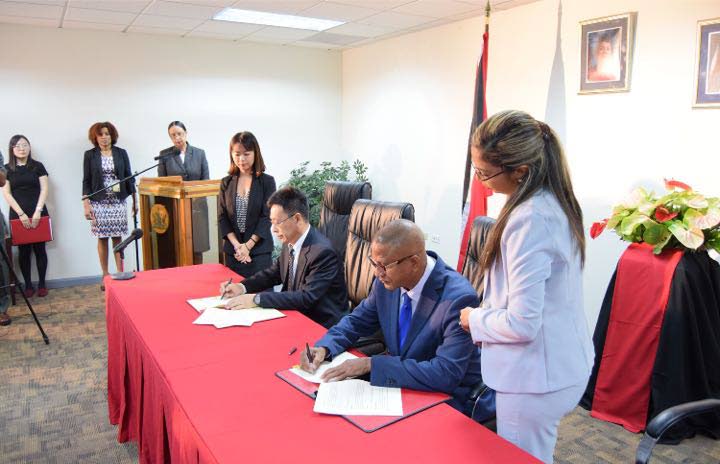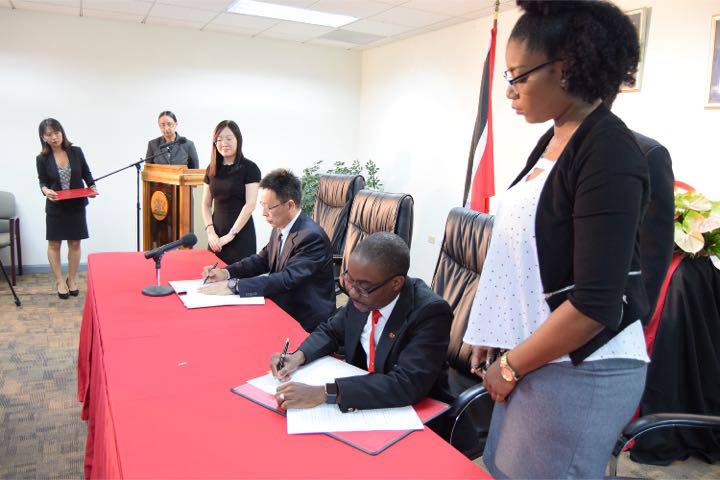China belts TT

Government, through state enterprise Evolving Technologies and Enterprise Development Company (eTecK), on Monday officially signed off on a memorandum of understanding with Chinese mega firm, Beijing Construction and Engineering Group for the US$104 million (TT$702 million) Phoenix Park Industrial Estate— the first step to a revamped economic alliance between TT and China.
The deal is among three major projects negotiated by both governments after a delegation, headed by Prime Minister Dr Keith Rowley, made an official visit to China in May. The other two developments include a code sharing agreement between Air China and Caribbean Airlines, and a supply deal between Lake Asphalt (LATT) and Beijing Construction and Engineering Group (BCEG). On Sunday, the BCEG team visited LATT in La Brea to tour the Pitch Lake and hold discussions with its management. LATT and BCEG also signed a memorandum of understanding (MoU) on Tuesday for a distribution agreement. TT pitch, the PM said when he returned from China, will be used to pave the runways of the new Beijing airport.
Communications Minister Stuart Young, Trade Minister Paula Gopee-Scoon, Energy Minister Franklin Khan and Foreign Affairs Minister Dennis Moses were on hand to witness the MoU signing. The park will be financed through a concessional loan from the Chinese government. Construction is expected to start later this year and, Young said Government negotiated for 60 per cent local labour and 50 per cent local content to be used. But it’s more than just construction, Government insists—it’s long-term Chinese investment in TT.

The TT investment is part of China’s international Belt and Road Initiative — a massive economic initiative announced in 2013 by Chinese leader Xi Jinping. Based on the old Silk Road trade route, the plan involves over 60 countries, mainly in Eurasia and Africa and is estimated to cost up to US$4 trillion. Rowley has been adamant that part of Government’s plan is finding new foreign investment in TT, away from the traditional powers like the US and UK.
During his trip, Rowley said recently at a political rally in Barataria, both governments took part in “serious discussions.” TT is not just interested in contractors coming into to build and leave, but firms investing in our future, he said.
“We told them we need your investment and you need our location in the Caribbean,” he said.
As the world economy evolves, Rowley said, so too must TT: “Foreign investment came to this country from Britain and later from the United States, and all along we’ve had this foreign investment inflow. But today China is the world’s second-largest economy so while the economy of Britain drove us for a while and the US for another period, if we are to tap into serious inflows of foreign direct investment we have to look into countries that are looking for investment opportunities abroad and China is that today.”
Young said Government is moving "full speed ahead" with this first phase of Chinese investment. Asked to clarify if this was an actual investment and not just an agreement, Young reiterated that it was part of the deal negotiated by TT in China, and there were different stages. From here, he said, the process will move to the commercial negotiation agreement.
"We will let you know when the first stone is turned," he said. The park will have ten "anchor" tenants to start with, mostly in ICT, biomedical engineering and new materials technology. Once completed, the park will have space for 60 to 80 factories, and will directly employ 4,500 people.


Comments
"China belts TT"